ACC231: Analyzing How Performance Management Enhances Profitability
VerifiedAdded on 2022/11/14
|8
|2115
|111
Report
AI Summary
This report delves into the critical relationship between performance management and profit maximization within organizations. It argues that effective performance management, encompassing strategies like employee reviews and motivational techniques, is essential for achieving higher profitability. The report highlights the importance of employee engagement and dedication in a competitive market, emphasizing the role of higher authorities in guiding and supervising employees. It examines tools like employee review processes and grading systems to enhance productivity, and stresses the significance of motivation, particularly through the application of Maslow's hierarchy of needs. The report uses the example of Tesco to illustrate how meeting employee needs can boost performance and, consequently, profits. Furthermore, the report discusses the importance of trust between management and employees, along with financial planning and risk management, as integral components of a comprehensive performance management system designed to enhance business outcomes. In conclusion, the report underscores that performance management is a fundamental driver of profit maximization.
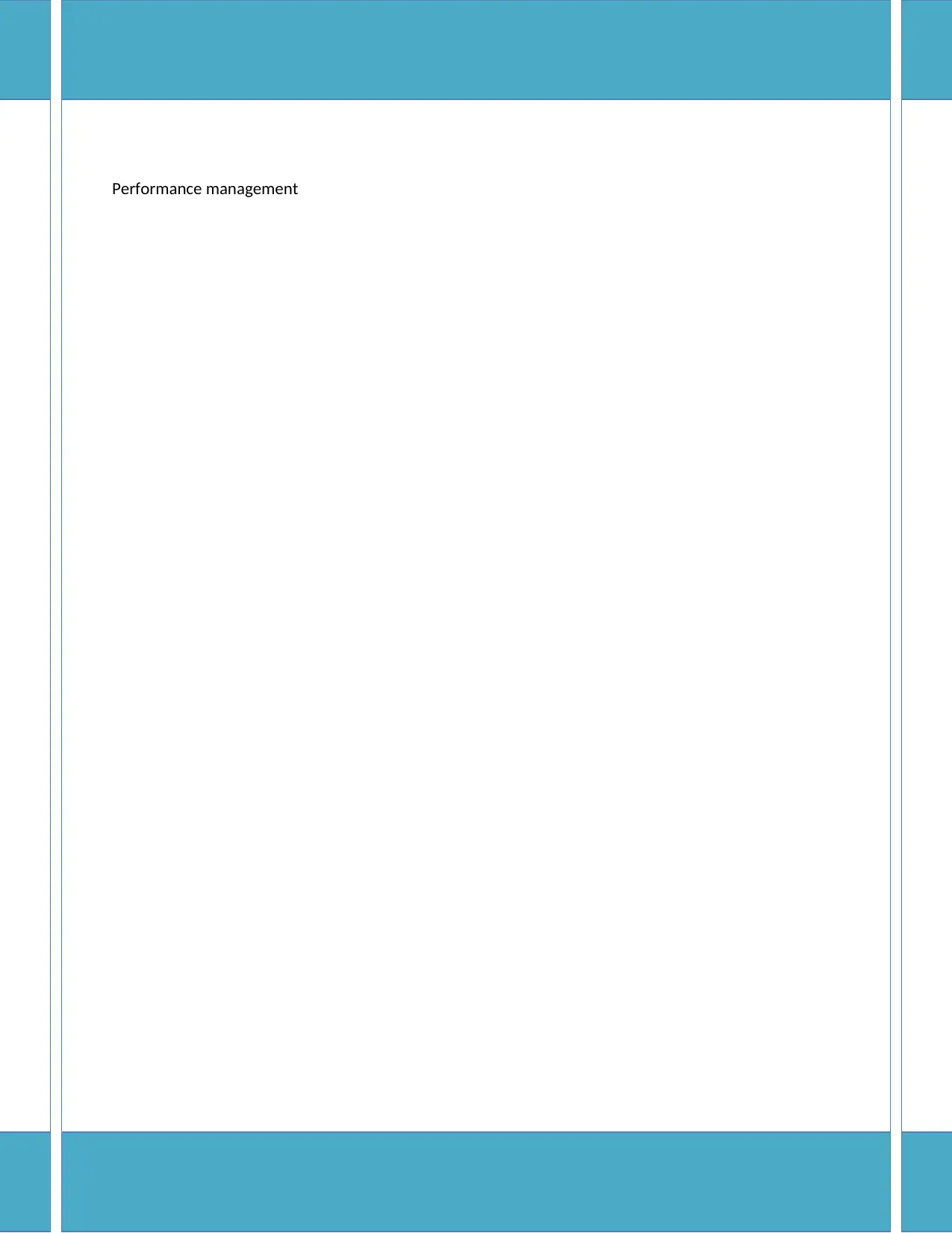
Performance management
Paraphrase This Document
Need a fresh take? Get an instant paraphrase of this document with our AI Paraphraser
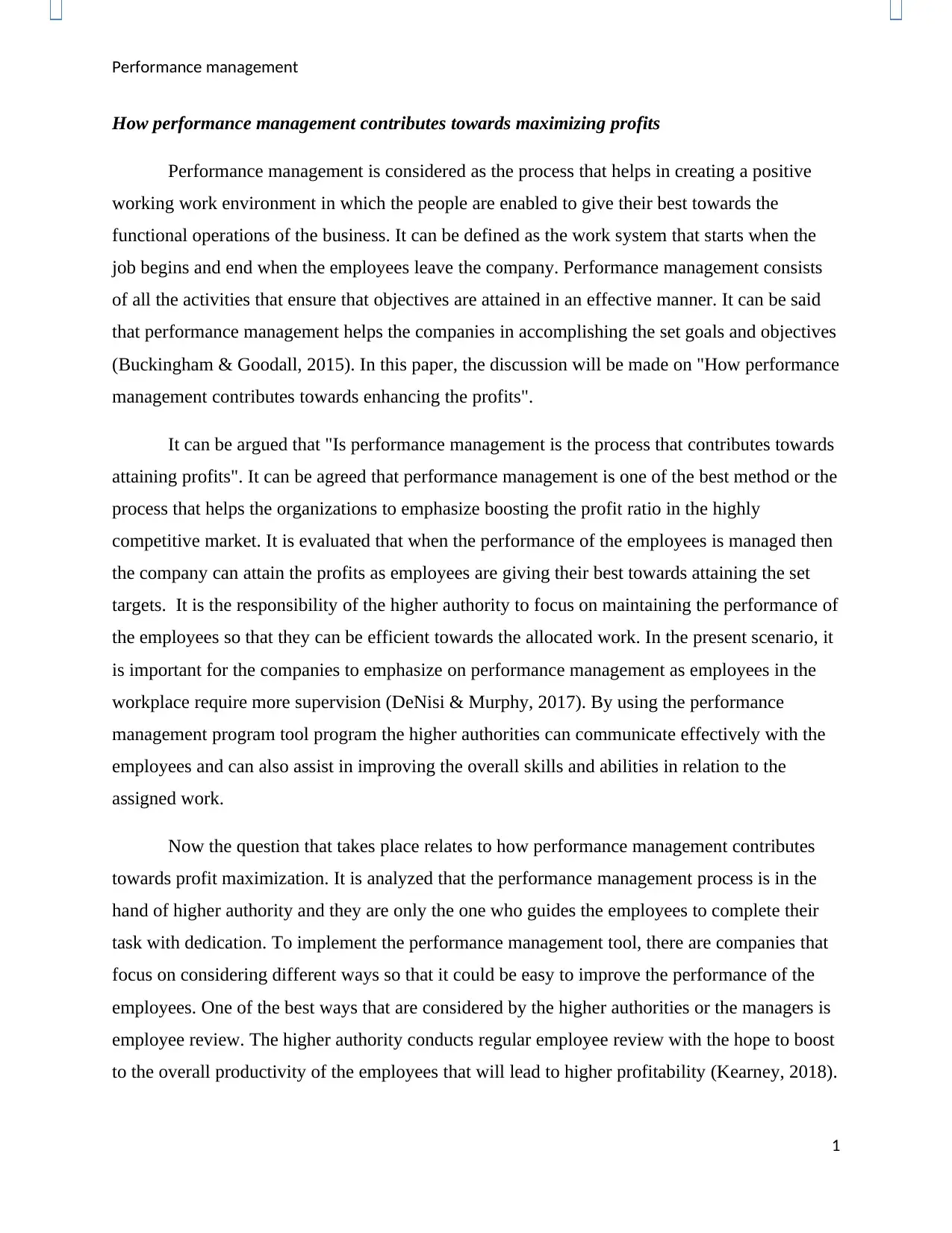
Performance management
How performance management contributes towards maximizing profits
Performance management is considered as the process that helps in creating a positive
working work environment in which the people are enabled to give their best towards the
functional operations of the business. It can be defined as the work system that starts when the
job begins and end when the employees leave the company. Performance management consists
of all the activities that ensure that objectives are attained in an effective manner. It can be said
that performance management helps the companies in accomplishing the set goals and objectives
(Buckingham & Goodall, 2015). In this paper, the discussion will be made on "How performance
management contributes towards enhancing the profits".
It can be argued that "Is performance management is the process that contributes towards
attaining profits". It can be agreed that performance management is one of the best method or the
process that helps the organizations to emphasize boosting the profit ratio in the highly
competitive market. It is evaluated that when the performance of the employees is managed then
the company can attain the profits as employees are giving their best towards attaining the set
targets. It is the responsibility of the higher authority to focus on maintaining the performance of
the employees so that they can be efficient towards the allocated work. In the present scenario, it
is important for the companies to emphasize on performance management as employees in the
workplace require more supervision (DeNisi & Murphy, 2017). By using the performance
management program tool program the higher authorities can communicate effectively with the
employees and can also assist in improving the overall skills and abilities in relation to the
assigned work.
Now the question that takes place relates to how performance management contributes
towards profit maximization. It is analyzed that the performance management process is in the
hand of higher authority and they are only the one who guides the employees to complete their
task with dedication. To implement the performance management tool, there are companies that
focus on considering different ways so that it could be easy to improve the performance of the
employees. One of the best ways that are considered by the higher authorities or the managers is
employee review. The higher authority conducts regular employee review with the hope to boost
to the overall productivity of the employees that will lead to higher profitability (Kearney, 2018).
1
How performance management contributes towards maximizing profits
Performance management is considered as the process that helps in creating a positive
working work environment in which the people are enabled to give their best towards the
functional operations of the business. It can be defined as the work system that starts when the
job begins and end when the employees leave the company. Performance management consists
of all the activities that ensure that objectives are attained in an effective manner. It can be said
that performance management helps the companies in accomplishing the set goals and objectives
(Buckingham & Goodall, 2015). In this paper, the discussion will be made on "How performance
management contributes towards enhancing the profits".
It can be argued that "Is performance management is the process that contributes towards
attaining profits". It can be agreed that performance management is one of the best method or the
process that helps the organizations to emphasize boosting the profit ratio in the highly
competitive market. It is evaluated that when the performance of the employees is managed then
the company can attain the profits as employees are giving their best towards attaining the set
targets. It is the responsibility of the higher authority to focus on maintaining the performance of
the employees so that they can be efficient towards the allocated work. In the present scenario, it
is important for the companies to emphasize on performance management as employees in the
workplace require more supervision (DeNisi & Murphy, 2017). By using the performance
management program tool program the higher authorities can communicate effectively with the
employees and can also assist in improving the overall skills and abilities in relation to the
assigned work.
Now the question that takes place relates to how performance management contributes
towards profit maximization. It is analyzed that the performance management process is in the
hand of higher authority and they are only the one who guides the employees to complete their
task with dedication. To implement the performance management tool, there are companies that
focus on considering different ways so that it could be easy to improve the performance of the
employees. One of the best ways that are considered by the higher authorities or the managers is
employee review. The higher authority conducts regular employee review with the hope to boost
to the overall productivity of the employees that will lead to higher profitability (Kearney, 2018).
1

Performance management
The employee review process is done in which the higher authority or the managers
analyze the performance of the employees and give feedback so that employees can improve
their performance. This is an effective method as it helps to enhance the engagement level of the
employees towards the work assigned to them in the workplace. There are many companies who
consider the approach of grading the performance in which after reviewing the performance the
grading is given to employees. So, this is also an effective approach that assists in motivating the
employees towards the performance of other employees. Therefore, it can be said that if
performance management tool is considered by the management such as employee review
process then it would be easy for the workers to be more efficient towards the work (Kuvaas,
Buch & Dysvik, 2016).
Through performance management, the profits can be easily maximized as it has been
analyzed that when the employees work according to the given rules and regulations and perform
well then there is more scope of attaining the competitive advantage. It can be said that a
dedicated employee is an asset for the company and if they are dedicated towards their work then
there is scope to attain higher productivity. In the present era, the companies are facing huge
competition, so it is important to have employees who are dedicated and also engaged in the
assigned work by the management. At the time of managing the performance of the employees,
it is necessary for the management to focus on motivation so that positive feeling towards the
work can be generated of the employees (Mone & London, 2018).
Performance management is linked with motivating the employees so that they can focus
on attaining success and growth in the competitive market. Motivation is one of the factors that
should be considered by management at the time of performance management. It is necessary for
the higher authority to focus on boosting motivation by satisfying the basic needs of the
employees. If the basic needs of the employees are satisfied then it would help to boost the
productivity which will results in higher profits (Shields et al., 2015).
In relation to this, the Maslow hierarchy of needs theory is one of the effective models
that should be considered by the management so that the performance of the employees can be
maintained or enhanced. This model states that there are five needs that should be satisfied with
the employees so that productivity ratio can be enhanced. The five stages are Physiological
needs, safety, love and belongingness, esteem and self-actualization needs. These are the basic
2
The employee review process is done in which the higher authority or the managers
analyze the performance of the employees and give feedback so that employees can improve
their performance. This is an effective method as it helps to enhance the engagement level of the
employees towards the work assigned to them in the workplace. There are many companies who
consider the approach of grading the performance in which after reviewing the performance the
grading is given to employees. So, this is also an effective approach that assists in motivating the
employees towards the performance of other employees. Therefore, it can be said that if
performance management tool is considered by the management such as employee review
process then it would be easy for the workers to be more efficient towards the work (Kuvaas,
Buch & Dysvik, 2016).
Through performance management, the profits can be easily maximized as it has been
analyzed that when the employees work according to the given rules and regulations and perform
well then there is more scope of attaining the competitive advantage. It can be said that a
dedicated employee is an asset for the company and if they are dedicated towards their work then
there is scope to attain higher productivity. In the present era, the companies are facing huge
competition, so it is important to have employees who are dedicated and also engaged in the
assigned work by the management. At the time of managing the performance of the employees,
it is necessary for the management to focus on motivation so that positive feeling towards the
work can be generated of the employees (Mone & London, 2018).
Performance management is linked with motivating the employees so that they can focus
on attaining success and growth in the competitive market. Motivation is one of the factors that
should be considered by management at the time of performance management. It is necessary for
the higher authority to focus on boosting motivation by satisfying the basic needs of the
employees. If the basic needs of the employees are satisfied then it would help to boost the
productivity which will results in higher profits (Shields et al., 2015).
In relation to this, the Maslow hierarchy of needs theory is one of the effective models
that should be considered by the management so that the performance of the employees can be
maintained or enhanced. This model states that there are five needs that should be satisfied with
the employees so that productivity ratio can be enhanced. The five stages are Physiological
needs, safety, love and belongingness, esteem and self-actualization needs. These are the basic
2
⊘ This is a preview!⊘
Do you want full access?
Subscribe today to unlock all pages.

Trusted by 1+ million students worldwide
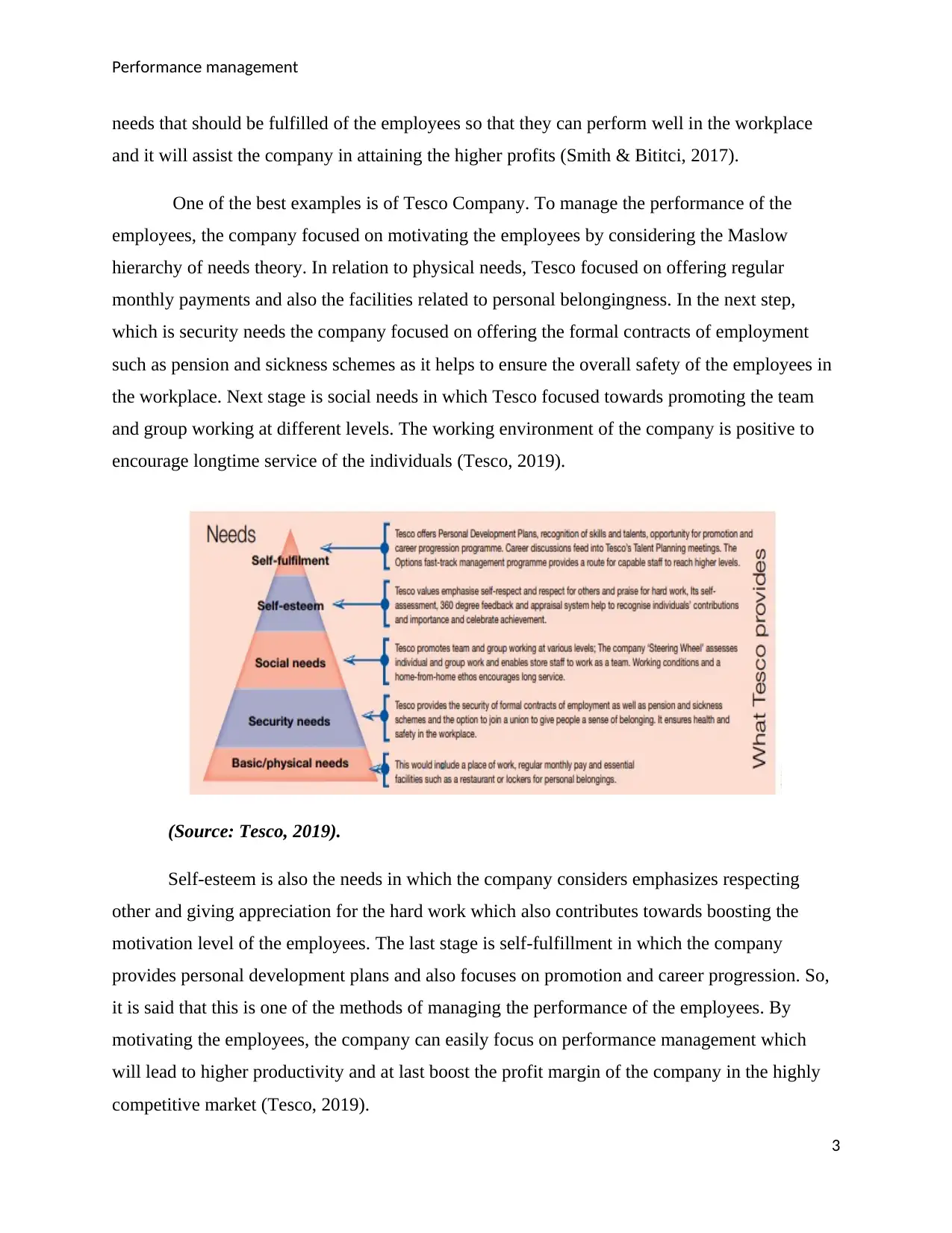
Performance management
needs that should be fulfilled of the employees so that they can perform well in the workplace
and it will assist the company in attaining the higher profits (Smith & Bititci, 2017).
One of the best examples is of Tesco Company. To manage the performance of the
employees, the company focused on motivating the employees by considering the Maslow
hierarchy of needs theory. In relation to physical needs, Tesco focused on offering regular
monthly payments and also the facilities related to personal belongingness. In the next step,
which is security needs the company focused on offering the formal contracts of employment
such as pension and sickness schemes as it helps to ensure the overall safety of the employees in
the workplace. Next stage is social needs in which Tesco focused towards promoting the team
and group working at different levels. The working environment of the company is positive to
encourage longtime service of the individuals (Tesco, 2019).
(Source: Tesco, 2019).
Self-esteem is also the needs in which the company considers emphasizes respecting
other and giving appreciation for the hard work which also contributes towards boosting the
motivation level of the employees. The last stage is self-fulfillment in which the company
provides personal development plans and also focuses on promotion and career progression. So,
it is said that this is one of the methods of managing the performance of the employees. By
motivating the employees, the company can easily focus on performance management which
will lead to higher productivity and at last boost the profit margin of the company in the highly
competitive market (Tesco, 2019).
3
needs that should be fulfilled of the employees so that they can perform well in the workplace
and it will assist the company in attaining the higher profits (Smith & Bititci, 2017).
One of the best examples is of Tesco Company. To manage the performance of the
employees, the company focused on motivating the employees by considering the Maslow
hierarchy of needs theory. In relation to physical needs, Tesco focused on offering regular
monthly payments and also the facilities related to personal belongingness. In the next step,
which is security needs the company focused on offering the formal contracts of employment
such as pension and sickness schemes as it helps to ensure the overall safety of the employees in
the workplace. Next stage is social needs in which Tesco focused towards promoting the team
and group working at different levels. The working environment of the company is positive to
encourage longtime service of the individuals (Tesco, 2019).
(Source: Tesco, 2019).
Self-esteem is also the needs in which the company considers emphasizes respecting
other and giving appreciation for the hard work which also contributes towards boosting the
motivation level of the employees. The last stage is self-fulfillment in which the company
provides personal development plans and also focuses on promotion and career progression. So,
it is said that this is one of the methods of managing the performance of the employees. By
motivating the employees, the company can easily focus on performance management which
will lead to higher productivity and at last boost the profit margin of the company in the highly
competitive market (Tesco, 2019).
3
Paraphrase This Document
Need a fresh take? Get an instant paraphrase of this document with our AI Paraphraser
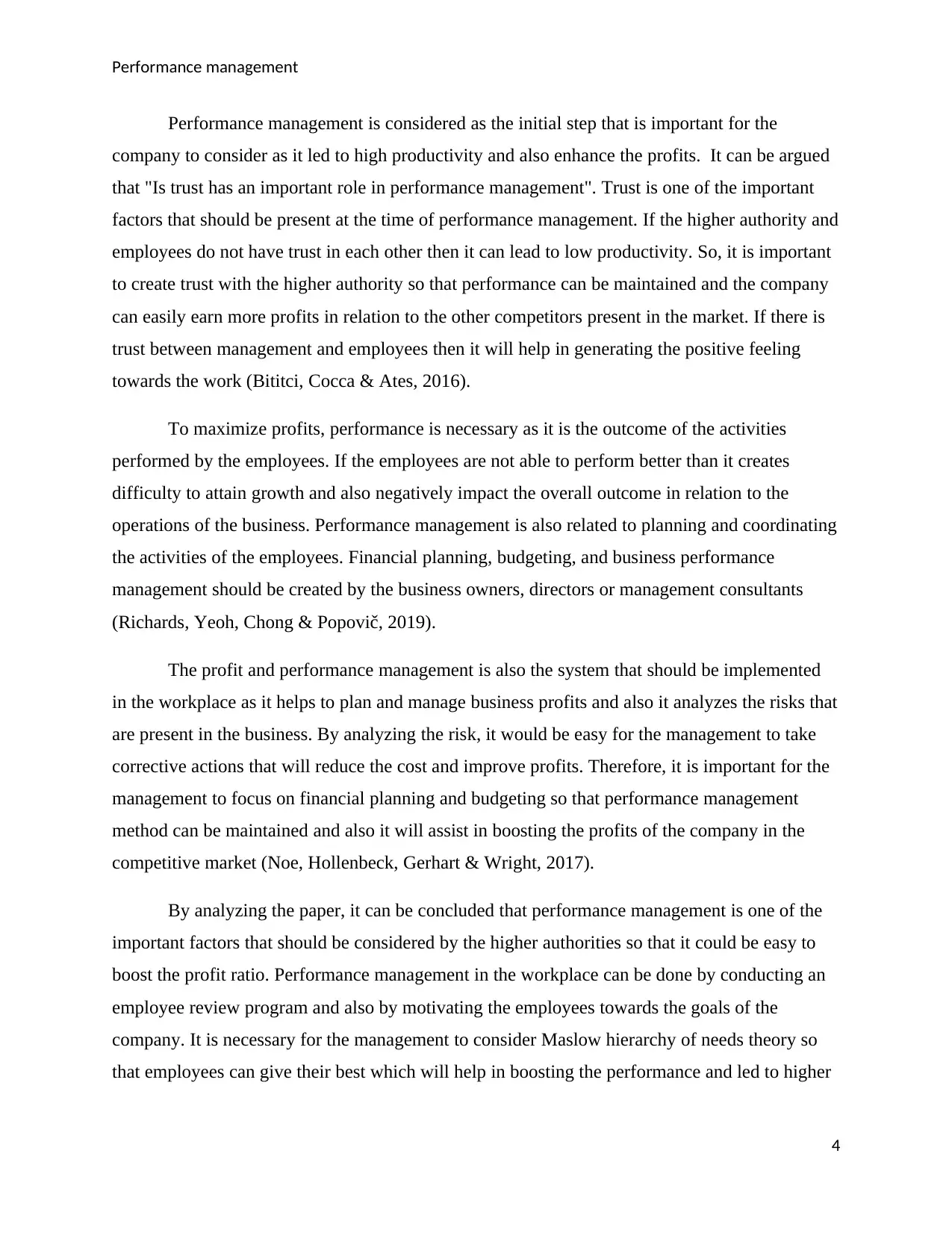
Performance management
Performance management is considered as the initial step that is important for the
company to consider as it led to high productivity and also enhance the profits. It can be argued
that "Is trust has an important role in performance management". Trust is one of the important
factors that should be present at the time of performance management. If the higher authority and
employees do not have trust in each other then it can lead to low productivity. So, it is important
to create trust with the higher authority so that performance can be maintained and the company
can easily earn more profits in relation to the other competitors present in the market. If there is
trust between management and employees then it will help in generating the positive feeling
towards the work (Bititci, Cocca & Ates, 2016).
To maximize profits, performance is necessary as it is the outcome of the activities
performed by the employees. If the employees are not able to perform better than it creates
difficulty to attain growth and also negatively impact the overall outcome in relation to the
operations of the business. Performance management is also related to planning and coordinating
the activities of the employees. Financial planning, budgeting, and business performance
management should be created by the business owners, directors or management consultants
(Richards, Yeoh, Chong & Popovič, 2019).
The profit and performance management is also the system that should be implemented
in the workplace as it helps to plan and manage business profits and also it analyzes the risks that
are present in the business. By analyzing the risk, it would be easy for the management to take
corrective actions that will reduce the cost and improve profits. Therefore, it is important for the
management to focus on financial planning and budgeting so that performance management
method can be maintained and also it will assist in boosting the profits of the company in the
competitive market (Noe, Hollenbeck, Gerhart & Wright, 2017).
By analyzing the paper, it can be concluded that performance management is one of the
important factors that should be considered by the higher authorities so that it could be easy to
boost the profit ratio. Performance management in the workplace can be done by conducting an
employee review program and also by motivating the employees towards the goals of the
company. It is necessary for the management to consider Maslow hierarchy of needs theory so
that employees can give their best which will help in boosting the performance and led to higher
4
Performance management is considered as the initial step that is important for the
company to consider as it led to high productivity and also enhance the profits. It can be argued
that "Is trust has an important role in performance management". Trust is one of the important
factors that should be present at the time of performance management. If the higher authority and
employees do not have trust in each other then it can lead to low productivity. So, it is important
to create trust with the higher authority so that performance can be maintained and the company
can easily earn more profits in relation to the other competitors present in the market. If there is
trust between management and employees then it will help in generating the positive feeling
towards the work (Bititci, Cocca & Ates, 2016).
To maximize profits, performance is necessary as it is the outcome of the activities
performed by the employees. If the employees are not able to perform better than it creates
difficulty to attain growth and also negatively impact the overall outcome in relation to the
operations of the business. Performance management is also related to planning and coordinating
the activities of the employees. Financial planning, budgeting, and business performance
management should be created by the business owners, directors or management consultants
(Richards, Yeoh, Chong & Popovič, 2019).
The profit and performance management is also the system that should be implemented
in the workplace as it helps to plan and manage business profits and also it analyzes the risks that
are present in the business. By analyzing the risk, it would be easy for the management to take
corrective actions that will reduce the cost and improve profits. Therefore, it is important for the
management to focus on financial planning and budgeting so that performance management
method can be maintained and also it will assist in boosting the profits of the company in the
competitive market (Noe, Hollenbeck, Gerhart & Wright, 2017).
By analyzing the paper, it can be concluded that performance management is one of the
important factors that should be considered by the higher authorities so that it could be easy to
boost the profit ratio. Performance management in the workplace can be done by conducting an
employee review program and also by motivating the employees towards the goals of the
company. It is necessary for the management to consider Maslow hierarchy of needs theory so
that employees can give their best which will help in boosting the performance and led to higher
4
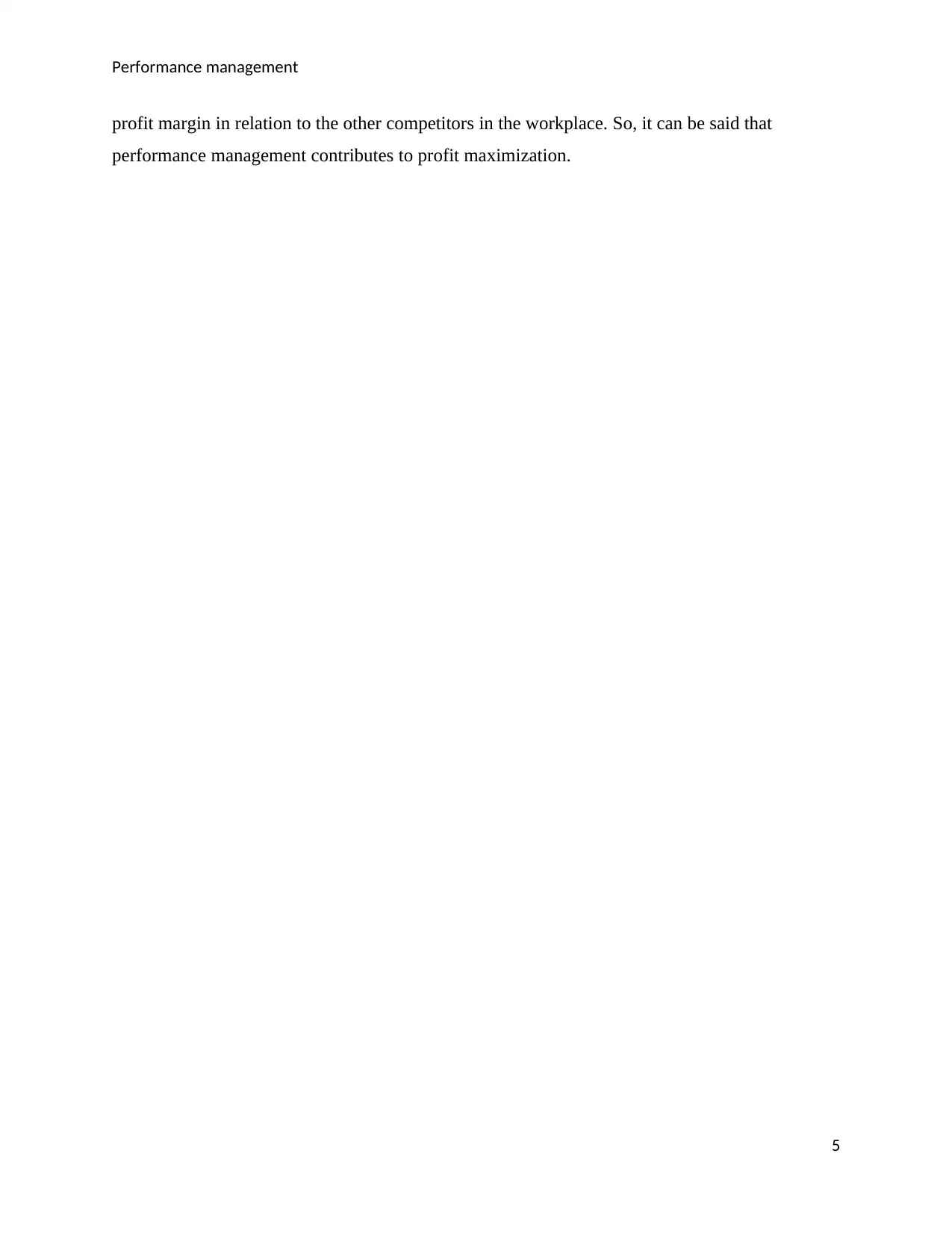
Performance management
profit margin in relation to the other competitors in the workplace. So, it can be said that
performance management contributes to profit maximization.
5
profit margin in relation to the other competitors in the workplace. So, it can be said that
performance management contributes to profit maximization.
5
⊘ This is a preview!⊘
Do you want full access?
Subscribe today to unlock all pages.

Trusted by 1+ million students worldwide
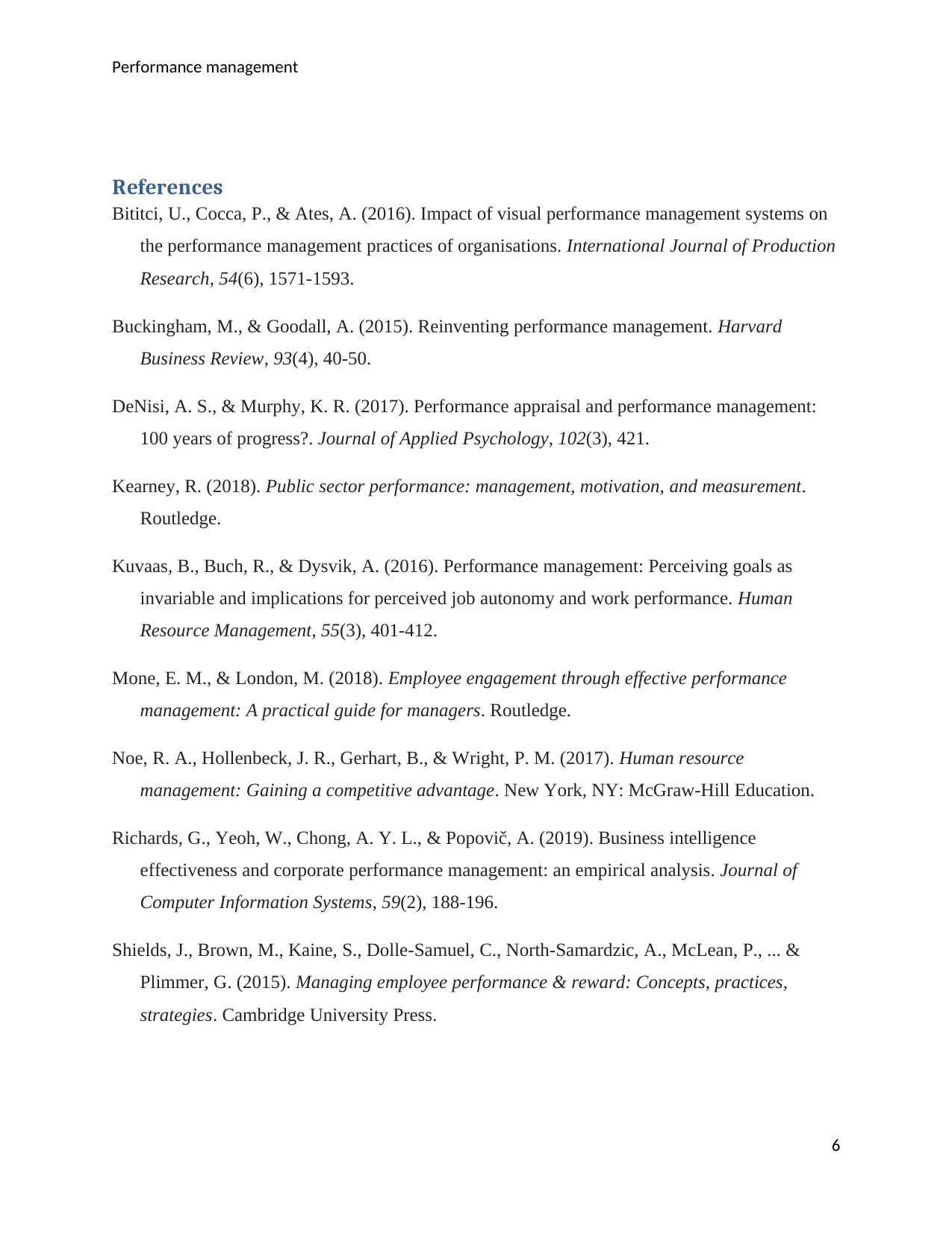
Performance management
References
Bititci, U., Cocca, P., & Ates, A. (2016). Impact of visual performance management systems on
the performance management practices of organisations. International Journal of Production
Research, 54(6), 1571-1593.
Buckingham, M., & Goodall, A. (2015). Reinventing performance management. Harvard
Business Review, 93(4), 40-50.
DeNisi, A. S., & Murphy, K. R. (2017). Performance appraisal and performance management:
100 years of progress?. Journal of Applied Psychology, 102(3), 421.
Kearney, R. (2018). Public sector performance: management, motivation, and measurement.
Routledge.
Kuvaas, B., Buch, R., & Dysvik, A. (2016). Performance management: Perceiving goals as
invariable and implications for perceived job autonomy and work performance. Human
Resource Management, 55(3), 401-412.
Mone, E. M., & London, M. (2018). Employee engagement through effective performance
management: A practical guide for managers. Routledge.
Noe, R. A., Hollenbeck, J. R., Gerhart, B., & Wright, P. M. (2017). Human resource
management: Gaining a competitive advantage. New York, NY: McGraw-Hill Education.
Richards, G., Yeoh, W., Chong, A. Y. L., & Popovič, A. (2019). Business intelligence
effectiveness and corporate performance management: an empirical analysis. Journal of
Computer Information Systems, 59(2), 188-196.
Shields, J., Brown, M., Kaine, S., Dolle-Samuel, C., North-Samardzic, A., McLean, P., ... &
Plimmer, G. (2015). Managing employee performance & reward: Concepts, practices,
strategies. Cambridge University Press.
6
References
Bititci, U., Cocca, P., & Ates, A. (2016). Impact of visual performance management systems on
the performance management practices of organisations. International Journal of Production
Research, 54(6), 1571-1593.
Buckingham, M., & Goodall, A. (2015). Reinventing performance management. Harvard
Business Review, 93(4), 40-50.
DeNisi, A. S., & Murphy, K. R. (2017). Performance appraisal and performance management:
100 years of progress?. Journal of Applied Psychology, 102(3), 421.
Kearney, R. (2018). Public sector performance: management, motivation, and measurement.
Routledge.
Kuvaas, B., Buch, R., & Dysvik, A. (2016). Performance management: Perceiving goals as
invariable and implications for perceived job autonomy and work performance. Human
Resource Management, 55(3), 401-412.
Mone, E. M., & London, M. (2018). Employee engagement through effective performance
management: A practical guide for managers. Routledge.
Noe, R. A., Hollenbeck, J. R., Gerhart, B., & Wright, P. M. (2017). Human resource
management: Gaining a competitive advantage. New York, NY: McGraw-Hill Education.
Richards, G., Yeoh, W., Chong, A. Y. L., & Popovič, A. (2019). Business intelligence
effectiveness and corporate performance management: an empirical analysis. Journal of
Computer Information Systems, 59(2), 188-196.
Shields, J., Brown, M., Kaine, S., Dolle-Samuel, C., North-Samardzic, A., McLean, P., ... &
Plimmer, G. (2015). Managing employee performance & reward: Concepts, practices,
strategies. Cambridge University Press.
6
Paraphrase This Document
Need a fresh take? Get an instant paraphrase of this document with our AI Paraphraser

Performance management
Smith, M., & Bititci, U. S. (2017). Interplay between performance measurement and
management, employee engagement and performance. International Journal of Operations
& Production Management, 37(9), 1207-1228.
Tesco .(2019). Motivational theory. Retrived from:
https://is.muni.cz/el/1451/podzim2013/np2330/tesco_15_full.pdf
Van Dooren, W., Bouckaert, G., & Halligan, J. (2015). Performance management in the public
sector. Routledge.
7
Smith, M., & Bititci, U. S. (2017). Interplay between performance measurement and
management, employee engagement and performance. International Journal of Operations
& Production Management, 37(9), 1207-1228.
Tesco .(2019). Motivational theory. Retrived from:
https://is.muni.cz/el/1451/podzim2013/np2330/tesco_15_full.pdf
Van Dooren, W., Bouckaert, G., & Halligan, J. (2015). Performance management in the public
sector. Routledge.
7
1 out of 8
Related Documents
Your All-in-One AI-Powered Toolkit for Academic Success.
+13062052269
info@desklib.com
Available 24*7 on WhatsApp / Email
![[object Object]](/_next/static/media/star-bottom.7253800d.svg)
Unlock your academic potential
Copyright © 2020–2025 A2Z Services. All Rights Reserved. Developed and managed by ZUCOL.





